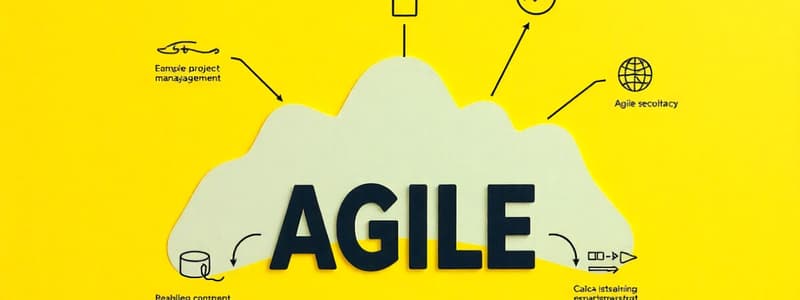Podcast
Questions and Answers
What is the name of the agile framework that James Newkirk is most familiar with?
What is the name of the agile framework that James Newkirk is most familiar with?
Scrum
What does James Newkirk recommend when implementing an agile framework?
What does James Newkirk recommend when implementing an agile framework?
Start small, make small changes and learn from them.
What is the primary measure of progress in agile development?
What is the primary measure of progress in agile development?
- Number of team members
- Completed project plans
- Working software (correct)
- Detailed documentation
Which principle of the Agile Manifesto emphasizes the importance of frequent software deliveries?
Which principle of the Agile Manifesto emphasizes the importance of frequent software deliveries?
Which agile value emphasizes the importance of collaboration and communication?
Which agile value emphasizes the importance of collaboration and communication?
Which agile principle promotes sustainable development?
Which agile principle promotes sustainable development?
Micromanagement is a highly effective approach in agile project management.
Micromanagement is a highly effective approach in agile project management.
Which of the following is considered a benefit of self-organizing teams in agile development?
Which of the following is considered a benefit of self-organizing teams in agile development?
Which of the following is NOT a core agile value as outlined in the Agile Manifesto?
Which of the following is NOT a core agile value as outlined in the Agile Manifesto?
The Agile Manifesto was published in what year?
The Agile Manifesto was published in what year?
Agile primarily focuses on methodologies rather than mindsets.
Agile primarily focuses on methodologies rather than mindsets.
What is the main purpose of the Agile Manifesto?
What is the main purpose of the Agile Manifesto?
Which of the following is NOT a core principle of the Agile Manifesto?
Which of the following is NOT a core principle of the Agile Manifesto?
Flashcards
Waterfall Model
Waterfall Model
A traditional project management approach with phases like requirements, design, implementation, testing, and maintenance.
Agile Development
Agile Development
A software development approach focusing on iterative development, early delivery, and customer collaboration.
Agile Manifesto
Agile Manifesto
The Agile Manifesto, a document outlining 4 core values and 12 principles for agile software development.
Backlog
Backlog
Signup and view all the flashcards
Backlog Refinement
Backlog Refinement
Signup and view all the flashcards
Burndown Chart
Burndown Chart
Signup and view all the flashcards
Daily Stand-up
Daily Stand-up
Signup and view all the flashcards
Definition of Done
Definition of Done
Signup and view all the flashcards
MVP (Minimum Viable Product)
MVP (Minimum Viable Product)
Signup and view all the flashcards
Epic
Epic
Signup and view all the flashcards
User Story
User Story
Signup and view all the flashcards
Pair Programming
Pair Programming
Signup and view all the flashcards
Retrospective
Retrospective
Signup and view all the flashcards
Continuous Integration
Continuous Integration
Signup and view all the flashcards
Kanban Board
Kanban Board
Signup and view all the flashcards
Lead Time
Lead Time
Signup and view all the flashcards
Sprint
Sprint
Signup and view all the flashcards
Unit Testing
Unit Testing
Signup and view all the flashcards
Velocity
Velocity
Signup and view all the flashcards
Refactoring
Refactoring
Signup and view all the flashcards
Information Radiators
Information Radiators
Signup and view all the flashcards
Iterative Development
Iterative Development
Signup and view all the flashcards
Test Driven Development (TDD)
Test Driven Development (TDD)
Signup and view all the flashcards
Value #1: Individuals and Interactions
Value #1: Individuals and Interactions
Signup and view all the flashcards
Value #2: Working Software
Value #2: Working Software
Signup and view all the flashcards
Value #3: Customer Collaboration
Value #3: Customer Collaboration
Signup and view all the flashcards
Value #4: Responding to Change
Value #4: Responding to Change
Signup and view all the flashcards
Principle #1: Customer Satisfaction
Principle #1: Customer Satisfaction
Signup and view all the flashcards
Principle #2: Embracing Change
Principle #2: Embracing Change
Signup and view all the flashcards
Principle #3: Frequent Delivery
Principle #3: Frequent Delivery
Signup and view all the flashcards
Principle #4: Collaboration
Principle #4: Collaboration
Signup and view all the flashcards
Principle #5: Trust and Motivation
Principle #5: Trust and Motivation
Signup and view all the flashcards
Principle #6: Face-to-Face Communication
Principle #6: Face-to-Face Communication
Signup and view all the flashcards
Principle #7: Working Software
Principle #7: Working Software
Signup and view all the flashcards
Principle #8: Sustainable Development
Principle #8: Sustainable Development
Signup and view all the flashcards
Principle #9: Technical Excellence
Principle #9: Technical Excellence
Signup and view all the flashcards
Principle #10: Simplicity
Principle #10: Simplicity
Signup and view all the flashcards
Principle #11: Self-Organizing Teams
Principle #11: Self-Organizing Teams
Signup and view all the flashcards
Principle #12: Continuous Improvement
Principle #12: Continuous Improvement
Signup and view all the flashcards
Study Notes
Course Information
- Course name: MGMT8085: Agile Principles
- Course overview: Introduction to Agile principles and methodologies, values, principles, and common roles in Agile teams
- Week 1 Class 1: Introduction & Welcome
- Course Format & Evaluations: Quizzes, assignments (due dates listed), midterm exam, group project (parts 1 & 2 due), and final exam are scheduled
- Resources: eConestoga, week-to-week content, PowerPoint slides, and an e-text resource (Agile Practice Guide, 190 pages, September 2017, published by PMI)
- Ice-breaker topics: Name, academic background, reasons for choosing Conestoga College, and learning goals for the semester
- Class structure: Lecture (35 min), Break (10 min), Lecture & Exercise (50 min), Break (10 min), Practice Exercise/Discuss Assignment/Evaluation (25 min), Asynchronous Hour (5 min), Summary (10 min), Q&A (5 min)
Agile Principles
- History of Agile: traditional project management (Waterfall, 1950s), evolution of Agile methodologies, formation of the Agile Alliance, publication of the Agile Manifesto, and development of Agile terms and concepts
- Agile Methodologies: Rapid Application Development (1980s), Adaptive Software Development (1990s), Crystal Agile Methodology (1991), Scrum Framework (1993), Dynamic System Development Method (1994), Extreme Programming (XP) (1996), and Feature Driven Development (FDD) (1997)
- Agile Alliance: Formation in 2001 at the Snowbird meeting, defining 4 values and the Agile Manifesto
- Agile Manifesto: Values: individuals and interactions, working software, customer collaboration, and responding to change; Principles: Early and continuous software delivery, welcoming changing requirements, delivering frequently, business people and developers working together, building projects around motivated individuals, trust and environment, efficient information transfer (face-to-face), sustainable development, attention to technical excellence, simplicity, best architectures, self-organizing teams, continuous improvement
- Agile Principles:
- Customer satisfaction through early and continuous delivery of valuable software.
- Welcoming changing requirements, even late in development.
- Delivering frequently.
- Collaboration between business people and developers.
- Motivated teams with the environment and support they need.
- Efficient communication (face-to-face).
- Sustainable development.
- Technical excellence and good design.
- Simplicity & reducing unnecessary work.
- Emergent architectures, requirements, and designs from self-organizing teams
- Continuous improvement through reflection.
- Traditional Project Management: Works well for predictable projects, struggles with uncertainty, product is delivered at the end
Agile Terms & Concepts
- Backlog, Backlog Refinement, Burndown Chart, Continuous Integration, Daily Stand-up, Definition of Done, Epic, Face-to-Face Communication, Incremental Development, Information Radiators, Kanban Board, Lead Time, MVP, Pair Programming, Refactoring, Retrospective, Test-Driven Development, Timebox, Unit Testing, User Story, Velocity
Implementing an Agile Mindset
- Learn and understand different agile frameworks and implement them carefully
- Focus on agile values and principles, implementing incremental changes
- Emphasize adaptability and continuous improvement
Next Steps
- Discussion of how agile values and principles relate to project management practices
- Exploring Lean and its connection to agile, common lean & agile practices used in project management
- Analyzing the relationship between agile values, principles, common practices, and their application in agile projects
- Deriving agile principles from the 4 Agile Manifesto values
Asynchronous Activity
- Review video "Introduction to Agile" by James Newkirk
- Answer questions:
- What agile framework is James Newkirk most familiar with?
- What is one thing James recommends when implementing an agile framework?
Studying That Suits You
Use AI to generate personalized quizzes and flashcards to suit your learning preferences.
Related Documents
Description
This quiz covers the introduction to Agile principles and methodologies, as discussed in the first week of the MGMT8085 course. It explores the history of Agile, including its evolution from traditional project management practices like Waterfall. Test your understanding of the Agile values, principles, and common roles in Agile teams.




